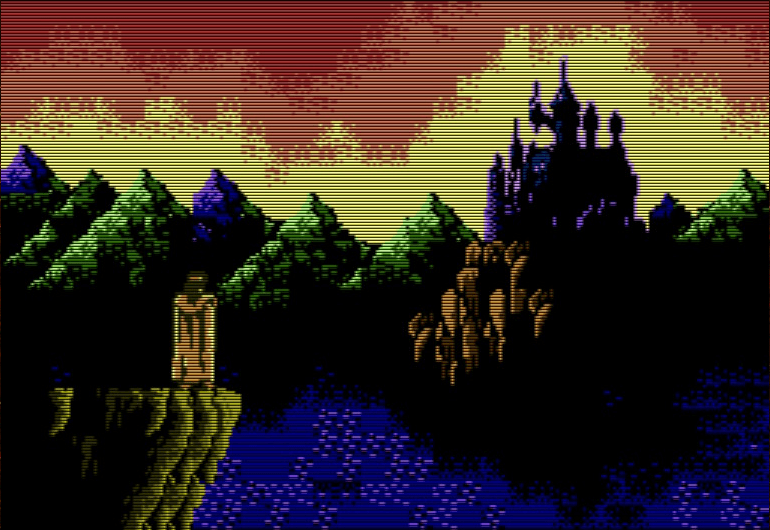It’s October and that means, like every other person worth knowing, I’ve been consuming only the spookiest of entertainment media. In the case of videogames, I started the month circling back to some survival horror titles I had missed (namely, Capcom’s Haunting Grounds but that’s for another post), but at some point, I reckon I felt the need to be a little more empowered in my escapist phantasmagoria and shifted to something less horror-filled but still horror-themed: Castlevania.
I intended this side-quest to last only long enough to make it through the first of the two Castlevania titles released for the PS2, Castlevania: Lament of Innocence. Before I knew it, however, I was booting up its successor, Castlevania: Curse of Darkness. And then wouldn’t you know it, as I sat on the couch watching whatever obscure title from the depths of the Horror category on whatever streaming service, I found myself playing through the earliest Castlevania titles for the NES, SNES, and Genesis (via the Castlevania Anniversary Collection for the Switch). Dear reader, this dalliance had turned into an obsession.
But, this hasn’t been my first encounter with the Prince of Darkness. In fact, with the exception of the two PS2 titles, this wasn’t my first time playing any of these games. I’ve long loved this series, though if I’m being honest, that love stems from a deep, deep affection for its pinnacle, Symphony of the Night. The series as a whole glows, for me, with the light reflected from that bright star, not unlike the moon that powers its immortal antagonist. As a kid, the first games were too hard, but still drew me in with the atmosphere and story. The Belmont’s sluggish movements combined with the seemingly endless barrage of quickly and often erratically moving enemies were just too much for me to overcome. This time around, though, my appreciation for each of these games has grown (thanks in no small part to the affordance of save states 😉).

Simon trudges onward (Castlevania, NES)
It feels a bit odd writing about Castlevania as though it’s a monolithic series like The Legend of Zelda or Mega Man where each game is, more often than not, so similar to the others in the series that they almost form a genre unto themselves. I think it perhaps makes the most sense to talk about Castlevania games in terms of eras: there’s the early 8- and 16-bit, side-scrolling adventure games; then the 2D, “metroidvania” games of the late 90s and early 2000s of which the aforementioned SotN remains the golden standard; and then still is the shift to 3D action games exemplified here by the PS2 entries. (A note: I’ve not played the Lord of Shadow titles for the PS3, nor the by-all-accounts-forgettable N64 games, nor the by-all-accounts-excellent titles for the DS, but I’d wager they still fit into this rather rudimentary classification.) Yet, throughout these differences in genre and the varying experiences they engender, one thing remains constant: the character of Dracula’s castle, Castlevania.
Even those early NES titles capture a sense of strangeness in their depiction of Castlevania. Despite the limited technological affordances, the original Castlevania feels different than your typical 8-bit side-scroller; there’s a feeling that’s there is more than meets the eye to the space around us. Take this screenshot for example: in the background sits the architecturally unsound chamber of Dracula while in the foreground, a small platform rests just before what looks like an open door, suggesting to the player that it might hold secrets worth uncovering. It doesn’t; you can’t reach it. But it gets one’s imagination going.
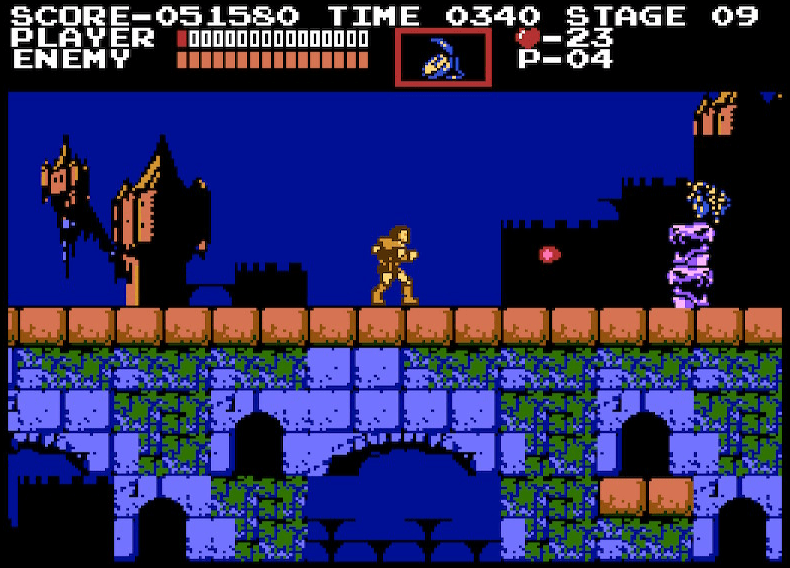
Dracula’s chamber juts up in the background, and an inaccessible landing in the foreground (Castlevania, NES)
Meanwhile, in Bloodlines for the Sega Genesis, we start to see rooms that adequately showcase just how topsy-turvy this place really is. Here are two of my favorite examples from that title, found in a later stage of the game. The first slowly reveals that space isn’t continuous in the castle as the depiction of the room rips apart like a poorly tracked VHS tape.
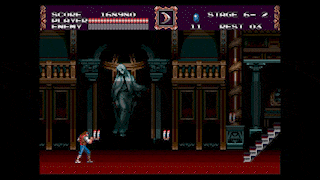
Space rips apart in this room of the castle (Castlevania: Bloodlines, Genesis)
The second, while perhaps a bit less inventive, nonetheless showcases that even gravity has no power over Castlevania. You’re on the ceiling, but it’s still the floor…and things fall….up? Whoa.
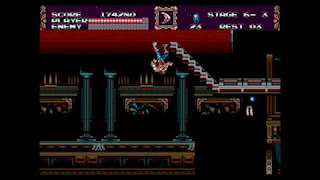
Up is down and dead is alive when Dracula’s in town (Castlevania: Bloodlines, Genesis)
These examples show how the space of these games, Castlevania itself, is a character in its own right. And the way the player makes sense of it affects the way they continue to create meaning throughout their experience in it.
I first started thinking about the spaces of Castlevania as I played through Lament of Innocence (2003), the first PS2 title of the series, and how it had adapts the experience of roaming the castle in SotN into a 3D space. I should state that I don’t find the two experiences to be all that similar on the surface. As mentioned above, the two games seemingly belong to separate genres with one more focused on exploration of a space and the other more on combat in order to traverse the space. And yet, there’s a shared DNA of design that runs through the two games. First and foremost is the use of the familiar blue map that you find yourself checking over and over again to be sure that A) you’re headed in the direction you mean to be and B) that there aren’t any conspicuous gaps in the map’s walls that typically indicate a hidden path or chamber. Point B gets at that aesthetic of exploration that is so much a part of the “metroidvania” genre of games, and here it’s essentially a difference of degree rather than kind in how the two games deploy this. A more exploration heavy game might obscure the path forward this way, while a game with light exploration might hide some optional goodies. Point A, on the other hand, speaks to another aspect of that shared DNA altogether: the fixed perspective of the game’s spaces.
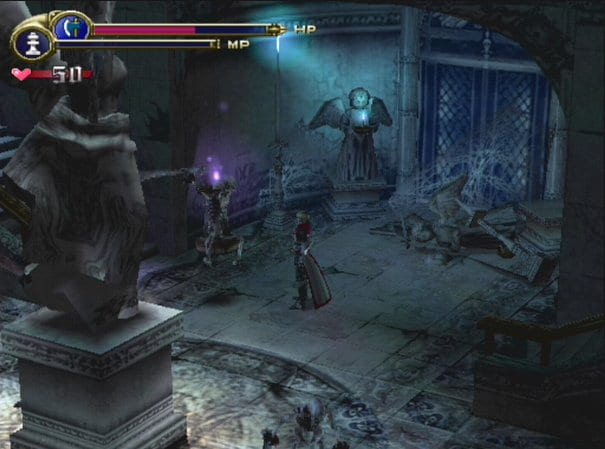
The vantage point of the player (Castlevania: Lament of Innocence, PS2)
SotN clearly has a fixed perspective because it’s a 2D game; the camera is “fixed” on the player character and their surroundings as if looking at a dollhouse cutaway at a 90 degree angle. LoI, on the other hand, is a 3D game and yet still employs a similar approach to the game’s camera. Each room/spaced is framed as though the player is looking down from a corner of the ceiling, sometimes panning with the movement of the player character, depending on the size of the space, but always fixed and unchangeable. The result is a feeling of disorientation – I was never confident in my understanding of the spaces I was in partly because my perception of that space shifted from behind my character and to the right to in front of my character and to the left. So the ideas of “left” and “right” quickly began to lose meaning, and I constantly had to check my map and triangulate my position and the position of the door I was aiming for as I made my way through the castle.
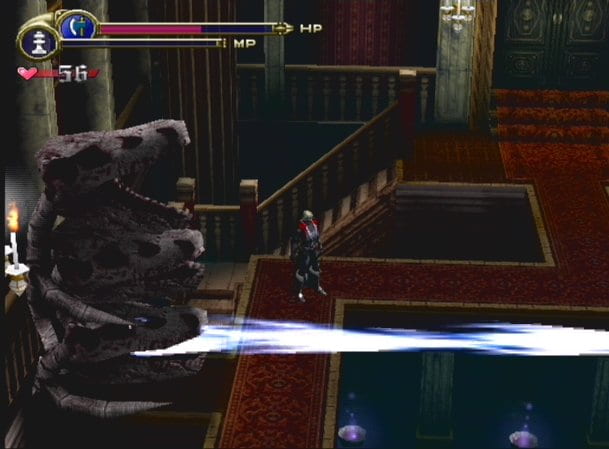
Players are unable to rotate the camera to see where they are jumping here (Castlevania: Lament of Innocence, PS2)
This is tedious enough when traversing a space for the first time – the as-of-yet-uncovered portions of the map functioned as a sort of “This Way, Dummy” sign that were easy enough to follow. But, near the endgame, when I would return to previous areas to access new rooms with keys found elsewhere, that kind of signposting was gone and it was very easy to get turned around. Yet, as frustrating as it might have been, I have to admit that it certainly lends Castlevania a tremendous amount of characterization. This is, after all, a magical place that defies all logic. It seems suiting that it should be frustrating to traverse, let alone make sense of.
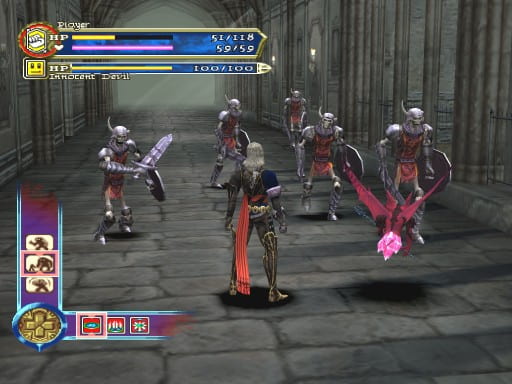
Players get a clear view of the obstacles and enemies around them (Castlevania: Curse of Darkness, PS2)
The next game released on the PS2 was 2005’s Curse of Darkness and, although several changes make this experience very different than its predecessor, the difference in its spatial representation harmonizes with the early game. CoD “remedies” the frustration of the fixed perspective by giving players control of the camera and setting its default position to an over the shoulder view of the character. This, of course, leads to a much more fluid and readable virtual space where the player’s spatial orientation is tied to their character’s. It’s important to note here, though, that the player character of this game isn’t a Belmont or any other vampire hunter, but a former servant of Dracula himself, Hector the Devil Forgemaster. So it makes sense for Hector to have a more lucid understanding of Castlevania as he’s been residing in it for some time before the events of the game (which is a direct sequel to the NES’ Castlevania III: Dracula’s Curse).
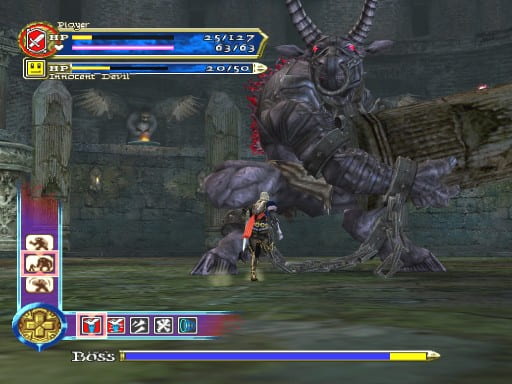
This spatial orientation makes combat a bit easier, as well, as the player can freely frame the target in the screen (Castlevania: Curse of Darkness, PS2)
Taken together, the spatial representations of these games underline the importance of considering how a player perceives a game’s space and designing that interface while keeping in mind your desired sense of identification between player and player character. And this consideration is all the more important because of the medium’s spatial qualities; what is the experience of playing a videogame if not running around a virtual space trying to make sense of it: figuring out where to go, what to interact with, what relationship various parts share with each other and with us?
